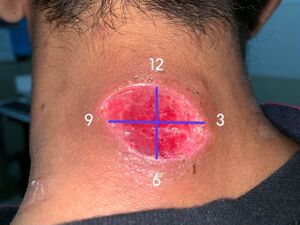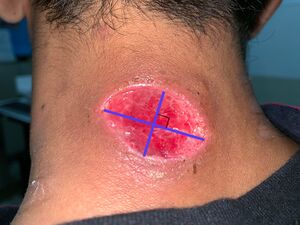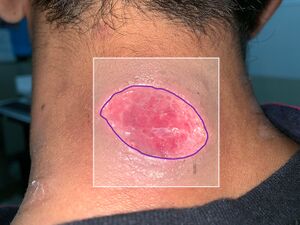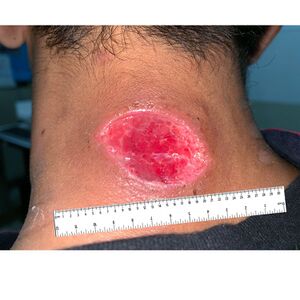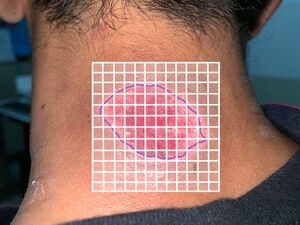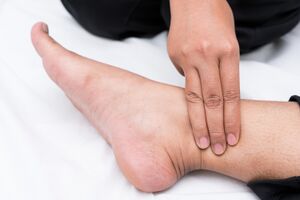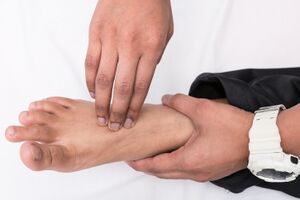Wound Care Basics: Objective Assessment: Difference between revisions
No edit summary |
No edit summary |
||
| Line 23: | Line 23: | ||
Remove the old dressing and thoroughly clean the wound with normal saline or with sterile water. The following is a guide to useful wound descriptors.<ref name=":0" /> Remember to describe the wound in a way that another healthcare provider will be unable to understand your documentation and followup your treatment plan. | Remove the old dressing and thoroughly clean the wound with normal saline or with sterile water. The following is a guide to useful wound descriptors.<ref name=":0" /> Remember to describe the wound in a way that another healthcare provider will be unable to understand your documentation and followup your treatment plan. | ||
==== '''Wound Location''' | ==== '''Wound Location'''<ref name=":0" /> ==== | ||
*Always use an anatomical landmark as reference when describing location | *Always use an anatomical landmark as reference when describing location | ||
*Be specific and use anatomical terms | *Be specific and use anatomical terms | ||
| Line 29: | Line 29: | ||
*For larger areas, you can narrow it down by region such as the distal one-third of the medial lower leg, five centimetres proximal to the medial malleolus, or 10 centimetres distal to the lateral knee joint. | *For larger areas, you can narrow it down by region such as the distal one-third of the medial lower leg, five centimetres proximal to the medial malleolus, or 10 centimetres distal to the lateral knee joint. | ||
==== '''Wound Shape''' | ==== '''Wound Shape'''<ref name=":0" /> ==== | ||
*Shape can give an indication of aetiology and helps document wound changes over time | *Shape can give an indication of aetiology and helps document wound changes over time | ||
*Possible descriptors include circular, round, oval, irregular, square, linear, punched out, or butterfly | *Possible descriptors include circular, round, oval, irregular, square, linear, punched out, or butterfly | ||
==== '''Wound Measurement''' | ==== '''Wound Measurement'''<ref name=":0" /> ==== | ||
*Wound dimensions are a significant outcome measure and are important to monitor response to treatment plan, as well as the prognosis for the wound. | *Wound dimensions are a significant outcome measure and are important to monitor response to treatment plan, as well as the prognosis for the wound. | ||
*Measurements should be taken in centimetres or millimetres from wound edge to wound edge, and should include (1) length, (2) width, (3) surface area, and (4) depth. Volume may also be calculated, but isn't as common unless it's a very large wound. | *Measurements should be taken in centimetres or millimetres from wound edge to wound edge, and should include (1) length, (2) width, (3) surface area, and (4) depth. Volume may also be calculated, but isn't as common unless it's a very large wound. | ||
| Line 106: | Line 106: | ||
|} | |} | ||
==== '''Wound edges''' | ==== '''Wound edges'''<ref name=":0" /> ==== | ||
* '''Sloped edges''' are desirable, they allow epithelial cells to migrate across the wound surface | * '''Sloped edges''' are desirable, they allow epithelial cells to migrate across the wound surface | ||
* '''Even or punched-out edges''' are usually the result of tissue hypoxia due to peripheral arterial disease, poor cardiac output, or anaemia | * '''Even or punched-out edges''' are usually the result of tissue hypoxia due to peripheral arterial disease, poor cardiac output, or anaemia | ||
| Line 116: | Line 116: | ||
** A '''tunnel''' has an entrance and an exit | ** A '''tunnel''' has an entrance and an exit | ||
==== '''Tissue type within the wound bed''' | ==== '''Tissue type within the wound bed'''<ref name=":0" /> ==== | ||
Tissue can be described as either viable or non-viable. | Tissue can be described as either viable or non-viable. | ||
| Line 129: | Line 129: | ||
** '''Eschar''' indicates deeper tissue damage. It can be black, grey, or brown. It is adherent to the wound bed and may be hard, spongy, rubbery, or leathery. Eschar is sometimes confused with scabs. A '''scab''' is a collection of dried blood cells, platelets, and serum on top of the skin surface, and the healing actually occurs beneath the scab, whereas eschar is non-viable tissue that must be removed to allow healing to occur. | ** '''Eschar''' indicates deeper tissue damage. It can be black, grey, or brown. It is adherent to the wound bed and may be hard, spongy, rubbery, or leathery. Eschar is sometimes confused with scabs. A '''scab''' is a collection of dried blood cells, platelets, and serum on top of the skin surface, and the healing actually occurs beneath the scab, whereas eschar is non-viable tissue that must be removed to allow healing to occur. | ||
==== '''Anatomical structures visible within the wound''': ==== | ==== '''Anatomical structures visible within the wound'''<ref name=":0" /> ==== | ||
It's important to document normal anatomical structures that are visible in the wound and to continuously monitor their health and viability. It is vital to be able to recognise tissue types for identification and debridement purposes. | It's important to document normal anatomical structures that are visible in the wound and to continuously monitor their health and viability. It is vital to be able to recognise tissue types for identification and debridement purposes. | ||
| Line 140: | Line 140: | ||
Document the percentage of tissue types, colour, and consistency seen in the wound bed. | Document the percentage of tissue types, colour, and consistency seen in the wound bed. | ||
==== '''Wound drainage''': ==== | ==== '''Wound drainage'''<ref name=":0" /> ==== | ||
When describing drainage (exudate) consider both the type and amount. Make note of drainage prior to removing dressing if there is strike through drainage on the outside of the dressing. Note drainage on the inside of the dressing before cleansing the wound. It is also important to note the amount of time since the last dressing change. Make note of any additional drainage that occurs after wound cleansing and during the wound care interventions. | When describing drainage (exudate) consider both the type and amount. Make note of drainage prior to removing dressing if there is strike through drainage on the outside of the dressing. Note drainage on the inside of the dressing before cleansing the wound. It is also important to note the amount of time since the last dressing change. Make note of any additional drainage that occurs after wound cleansing and during the wound care interventions. | ||
| Line 202: | Line 202: | ||
{| class="wikitable" | {| class="wikitable" | ||
|+ | |+ | ||
<ref name=":0" /> | |||
! | ! | ||
!'''Dressing''' | !'''Dressing''' | ||
| Line 250: | Line 251: | ||
|} | |} | ||
==== '''Wound Odour''': ==== | ==== '''Wound Odour'''<ref name=":0" /> ==== | ||
* Almost all wounds have some odour on dressing removal. Odour does not automatically suggest infection. | * Almost all wounds have some odour on dressing removal. Odour does not automatically suggest infection. | ||
| Line 257: | Line 258: | ||
** For example: if Dakin's solution was used, there will be a smell like bleach, Burrow's solution was used, it may smell like vinegar, povidone-iodine (betadine) will smell like iodine. Hydrocolloid dressings will have a distinctive smell as a result of the chemical reaction from autolytic debridement. | ** For example: if Dakin's solution was used, there will be a smell like bleach, Burrow's solution was used, it may smell like vinegar, povidone-iodine (betadine) will smell like iodine. Hydrocolloid dressings will have a distinctive smell as a result of the chemical reaction from autolytic debridement. | ||
==== '''Periwound Skin''': ==== | ==== '''Periwound Skin'''<ref name=":0" /> ==== | ||
Periwound skin involves the area around a wound that may be affected by "wound-related factors and/or underlying pathology" according to LeBlanc et al.<ref>LeBlanc K, Beeckman D, Campbell K et al (2021) [https://www.woundsinternational.com/resources/details/best-practice-recommendations-prevention-and-management-periwound-skin-complications Best practice recommendations for prevention and management of periwound skin complications].</ref> | |||
Periwound assessment should include the following: | |||
* '''Trophic changes:''' changes in skin texture, changes in nail beds, loss of hair, shiny skin | |||
* '''Skin discolouration:''' | |||
** '''Haemosiderin deposits''' are commonly seen in venous insufficiency | |||
** White spots called '''atrophie blanche''' are commonly seen with arterial disease | |||
** A '''haematoma''' (purple ecchymosis) points to possibility of deep tissue destruction | |||
** You may also see redness, darkening, purple spots, or other pigment changes that should be documented | |||
* '''Maceration''' is softening of tissue caused by excessive moisture. This tissue appears white due to a loss of pigmentation, it is often soft and soggy. | |||
* '''Induration''' is abnormal firmness of tissue with margins and sometimes has an orange peel appearance | |||
* '''Hydration or turgor''' | |||
* '''Hyperkeratosis''' (callus) | |||
* '''Oedema''' | |||
** Delays healing | |||
** Is a normal response seen in the inflammatory phase. It | |||
** Other causes could include: (1) dependent position, (2) venous insufficiency, (3) renal failure, or (4) right-sided congestive heart failure. | |||
** '''Pitting oedema''' is assessed by pressing your finger into the skin for five seconds and then releasing your finger. If the indentation stays, it's termed pitting oedema. Pitting oedema is often seen in congestive heart failure, venous insufficiency, and with DVTs. | |||
** '''Non-pitting oedema''' is stretched skin that is shiny and hard and is often seen in lymphoedema or angioedema. | |||
Videos: edema assessments | |||
===='''Blood flow'''<ref name=":0" /> ==== | |||
* Palpate the posterior tibial pulse and the dorsalis pedis pulse, document the presence and quality | |||
* If possible, perform the [[Ankle-Brachial Index|ankle brachial index]] and document the result | |||
<div class="row"> | |||
<div class="col-md-6"> [[File:Posterior tibial artery pulse.jpeg|none|thumb]]</div> | |||
<div class="col-md-6"> [[File:Dorsalis pedis pulse.jpeg|none|thumb]]</div> | |||
</div> | |||
[[File:Posterior tibial artery pulse.jpeg|none|thumb]] | |||
[[File:Dorsalis pedis pulse.jpeg|none|thumb]] | |||
==== '''Sensation'''. ==== | ==== '''Sensation'''. ==== | ||
| Line 288: | Line 315: | ||
== Resources == | == Resources == | ||
*So you'll get a chance to practise measuring and making a wound tracing during the lab portion for this course. | *So you'll get a chance to practise measuring and making a wound tracing during the lab portion for this course. | ||
* | *The pitting oedema severity scale | ||
or | or | ||
Revision as of 06:46, 14 February 2023
Top Contributors - Stacy Schiurring and Jess Bell
Introduction[edit | edit source]
Objective Assessment[edit | edit source]
Prepare the Patient[edit | edit source]
The objective assessment of the wound may take some time therefore it is important to consider the patient's position and comfort during the assessment. Ideal positioning will provide the patient both comfort and modesty while allowing the clinician full access to the treatment area.[1]
The following short video discusses principles of draping to provide patient privacy and comfort.
Old Wound Covering and Dressing Removal[edit | edit source]
When ready to begin your objective assessment of the wound, first note the appearance of the old dressing:
- is it intact or missing?
- note any drainage on inside and outside of dressing (strike through drainage)
- Is there areas of wear on the dressing?
Wound Description[edit | edit source]
Remove the old dressing and thoroughly clean the wound with normal saline or with sterile water. The following is a guide to useful wound descriptors.[1] Remember to describe the wound in a way that another healthcare provider will be unable to understand your documentation and followup your treatment plan.
Wound Location[1][edit | edit source]
- Always use an anatomical landmark as reference when describing location
- Be specific and use anatomical terms
- Document right/left, medial/lateral, distal/proximal, and cranial/caudal
- For larger areas, you can narrow it down by region such as the distal one-third of the medial lower leg, five centimetres proximal to the medial malleolus, or 10 centimetres distal to the lateral knee joint.
Wound Shape[1][edit | edit source]
- Shape can give an indication of aetiology and helps document wound changes over time
- Possible descriptors include circular, round, oval, irregular, square, linear, punched out, or butterfly
Wound Measurement[1][edit | edit source]
- Wound dimensions are a significant outcome measure and are important to monitor response to treatment plan, as well as the prognosis for the wound.
- Measurements should be taken in centimetres or millimetres from wound edge to wound edge, and should include (1) length, (2) width, (3) surface area, and (4) depth. Volume may also be calculated, but isn't as common unless it's a very large wound.
- Wound measurements are typically recorded once per week, but can be taken more frequently to capture rapid changes in fast healing or deteriorating wounds.
- Large stagnant or chronic wounds may only need to be measured every other week or monthly
- New measurements should be taken following a change in patient status or following a surgical intervention of the wound.
| Method of Wound Measurement | Description | Advantage of Method | Disadvantage of Method | Examples |
|---|---|---|---|---|
| Clock Method |
|
|
The greatest length and greatest width is not necessarily at 12 o'clock to six o'clock and three o'clock to nine o'clock, therefore it may not capture the true size of the wound. | |
| Perpendicular Method |
|
|
||
| Tracing Method |
|
|
|
|
| Photography |
|
|
Facilities may not have the equipment or the capabilities for digital photography | |
| Planimetry |
|
Computer planimetry is the standard method used in wound research, but is rarely used clinically due to cost and availability. |
Wound edges[1][edit | edit source]
- Sloped edges are desirable, they allow epithelial cells to migrate across the wound surface
- Even or punched-out edges are usually the result of tissue hypoxia due to peripheral arterial disease, poor cardiac output, or anaemia
- Uneven or serpentine edges are typically seen in venous insufficiency and are usually accompanied by oedema and periwound haemosiderin staining
- Epibole (rolled edges) occur when epithelial cells are unable to migrate across the wound surface. This can be caused by lack of tissue perfusion or nutrition, the presence of bacterial biofilm, infection, hypergranulation, or repeated trauma.
- Detached edges occur when the epithelium is detached from the subcutaneous tissue. Detached edges should be documented based on their location, using the clock as a reference. Measure the depth with a slightly saline-moistened cotton tip applicator.
- Undermining is shelf-like
- A sinus tract has an entrance, but no exit
- A tunnel has an entrance and an exit
Tissue type within the wound bed[1][edit | edit source]
Tissue can be described as either viable or non-viable.
- Viable tissue is bright, shiny, bouncy, taut, and moist. Viable tissue can be either granulation tissue or epithelial tissue.
- Granulation tissue is the new growth of small blood vessels and connective tissue. It is soft and spongy, and may bleed when touched. Granulation tissue is usually pale pink initially and then beefy red as it is vascularised.
- Healthy granulation tissue is bright red, shiny, granular, or bumpy with a velvety appearance
- Unhealthy granulation tissue is pale or dull red due to poor vascular supply. It may also be friable and disintegrate with dressing removal or with cleansing.
- Hypergranulation is an overgrowth of granulation tissue that rises above the level of the wound surface. It is irregular in shape and has large or swollen granules. Hypergranulation is typically due to maceration, infection, or friction on the wound bed. It must be removed for proper healing to occur.
- Epithelial tissue is pink or red in colour and has the appearance of new skin
- Granulation tissue is the new growth of small blood vessels and connective tissue. It is soft and spongy, and may bleed when touched. Granulation tissue is usually pale pink initially and then beefy red as it is vascularised.
- Non-viable tissue is necrotic or dead tissue within the wound bed. It must be removed for proper healing to occur and to decrease infection risk.
- Slough is non-viable subcutaneous tissue and by-products. It's usually yellow to tan in colour and can be mucousy or stringy. It's a result of the body breaking down dead cells and ranges from non-adherent to loosely adherent to tissue.
- Eschar indicates deeper tissue damage. It can be black, grey, or brown. It is adherent to the wound bed and may be hard, spongy, rubbery, or leathery. Eschar is sometimes confused with scabs. A scab is a collection of dried blood cells, platelets, and serum on top of the skin surface, and the healing actually occurs beneath the scab, whereas eschar is non-viable tissue that must be removed to allow healing to occur.
Anatomical structures visible within the wound[1][edit | edit source]
It's important to document normal anatomical structures that are visible in the wound and to continuously monitor their health and viability. It is vital to be able to recognise tissue types for identification and debridement purposes.
- Blood vessels are purple in colour when healthy, and black or brown in colour when unhealthy, clogged, or calcified.
- Fat is yellow and globular when healthy and appears shrivelled, brown when unhealthy.
- Muscle is pink or dark red, striated, firm, and resilient to pressure when healthy. It may jump or twitch when probed. When unhealthy, it appears brown, shrivelled, friable, and does not twitch.
- Tendons are white and shiny when healthy. They are covered with a white tendon sheath. When unhealthy, the sheath will be frayed or stringy, and the tendon will become yellow or brown. Ligaments and joint capsules have a similar appearance to tendons when healthy and unhealthy.
- Bone is beige or tan, hard and covered with a clear membrane (the periosteum) when healthy. When unhealthy, it is brown or black, and may be friable and disintegrate with palpation.
Document the percentage of tissue types, colour, and consistency seen in the wound bed.
Wound drainage[1][edit | edit source]
When describing drainage (exudate) consider both the type and amount. Make note of drainage prior to removing dressing if there is strike through drainage on the outside of the dressing. Note drainage on the inside of the dressing before cleansing the wound. It is also important to note the amount of time since the last dressing change. Make note of any additional drainage that occurs after wound cleansing and during the wound care interventions.
There are four primary types of wound drainage and, two additional types of drainage (serosanguineous and seropurulent) that are combinations of the primary types.
| Drainage Type | Description | When to Refer or Reassess | Example |
|---|---|---|---|
| Sanguineous drainage |
|
|
|
| Serous drainage |
|
If copious can indicate trauma to the wound, chronic inflammation due to biofilm or localised infection. | |
| Serosanguineous drainage |
|
If serous drainage changes to serosanguineous later in the healing process, it may indicate new trauma has occurred to the wound. | |
| Purulent drainage |
|
|
|
| Seropurulent drainage | Occurs when serous drainage starts to turn cloudy, yellow, or tan |
|
|
| Autolytic drainage |
|
Terminology used to describe amount of drainage:
| Dressing | Wound bed | Drainage during treatment | |
|---|---|---|---|
| None | Dry | Dry | None |
| Scant |
|
Moist | None |
| Minimal |
|
Moist | There may be some drainage on dressing removal, but no drainage occurs during treatment. |
| Moderate |
|
Wet | Some drainage is visible in the wound bed after dressing removal, as well as some drainage occuring during treatment. |
| Heavy |
|
Very wet | Drainage is visible immediately upon dressing removal, and continues throughout treatment. |
| Copious |
|
Filled with fluid and saturated |
|
Wound Odour[1][edit | edit source]
- Almost all wounds have some odour on dressing removal. Odour does not automatically suggest infection.
- Odour is concerning if the smell lingers after dressing removal and wound cleansing.
- Document the odour of the wound and not the odour from the topical agent, dressing, or the dressing by-product.
- For example: if Dakin's solution was used, there will be a smell like bleach, Burrow's solution was used, it may smell like vinegar, povidone-iodine (betadine) will smell like iodine. Hydrocolloid dressings will have a distinctive smell as a result of the chemical reaction from autolytic debridement.
Periwound Skin[1][edit | edit source]
Periwound skin involves the area around a wound that may be affected by "wound-related factors and/or underlying pathology" according to LeBlanc et al.[3]
Periwound assessment should include the following:
- Trophic changes: changes in skin texture, changes in nail beds, loss of hair, shiny skin
- Skin discolouration:
- Haemosiderin deposits are commonly seen in venous insufficiency
- White spots called atrophie blanche are commonly seen with arterial disease
- A haematoma (purple ecchymosis) points to possibility of deep tissue destruction
- You may also see redness, darkening, purple spots, or other pigment changes that should be documented
- Maceration is softening of tissue caused by excessive moisture. This tissue appears white due to a loss of pigmentation, it is often soft and soggy.
- Induration is abnormal firmness of tissue with margins and sometimes has an orange peel appearance
- Hydration or turgor
- Hyperkeratosis (callus)
- Oedema
- Delays healing
- Is a normal response seen in the inflammatory phase. It
- Other causes could include: (1) dependent position, (2) venous insufficiency, (3) renal failure, or (4) right-sided congestive heart failure.
- Pitting oedema is assessed by pressing your finger into the skin for five seconds and then releasing your finger. If the indentation stays, it's termed pitting oedema. Pitting oedema is often seen in congestive heart failure, venous insufficiency, and with DVTs.
- Non-pitting oedema is stretched skin that is shiny and hard and is often seen in lymphoedema or angioedema.
Videos: edema assessments
Blood flow[1][edit | edit source]
- Palpate the posterior tibial pulse and the dorsalis pedis pulse, document the presence and quality
- If possible, perform the ankle brachial index and document the result
Sensation.[edit | edit source]
- Test sensation using the Semmes-Weinstein monofilaments, and also assess light touch and pressure manually, heat/cold, and proprioception.
Infection:[edit | edit source]
- When assessing for infection, think IFEE: induration, fever, erythema, and oedema. So certain infections have a characteristic odour. It can be hard to distinguish infection from the normal inflammatory response. Key characteristics of infection include streaks of redness, increased warmth, intense pain, significant oedema, exudate changes from serous to purulent, and then also a strong odour. Systemic characteristic of infection include fever greater than 38,3 degrees Celsius or 101 degrees Fahrenheit. Chills, lethargy, restlessness, and confusion. Reddened skin with streaks leading away from the wound may mean cellulitis or necrotising fasciitis, an infection of the surrounding tissues that can be life and limb threatening, and this requires immediate consultation with the physician.
- Wound culture. So if an infection is suspected, a swab culture may be ordered. And in most practice environments, a physiotherapist can perform a swab culture. Be sure to use the Levine technique when performing a swab culture, and a description of this can be found in the resources section. First, clean the wound with sterile water or saline. Then you want to swab over clean granulation tissue only. Do not culture eschar, slough, or other nonviable tissue since the non-viable tissue has bacteria, but then no blood supply. So those toxins cannot be absorbed and cause an infection. If you swab non-viable tissue this will result in a positive culture that does not necessarily correspond to an active infection. While swabbing, be sure to apply sufficient pressure to expel wound drainage from deep within the wound and collect that on the culturette.
Joint biomechanical function,[edit | edit source]
- so you're going to want to look at joint passive and active range of motion, and then perform manual muscle testing, proximal and distal to the ulcer. Also perform any reflex testing of the involved extremity to assess for a neuropathy.
Wound Classification[edit | edit source]
Now let's get into wound classification. So during your wound evaluation, wounds are classified in several different categories. First of all, wounds are classified as either acute or chronic. Chronic wounds are wounds that have not finished the proliferative phase at the end of four weeks. So the wound is still open after four weeks, it's considered to be chronic. Wounds are also classified based on depth. And different wound types have different classification systems. A more thorough description of a few classification systems can be found in the resources section for this course. One way to classify depth is superficial, superficial partial thickness, deep partial thickness, and full thickness. Another common way to classify depth is based on the Bates-Jensen Wound Assessment Tool. Pressure injuries or pressure ulcers are staged using a system developed by the National Pressure Injury Advisory Panel, formerly known as the National Pressure Ulcer Advisory Panel. It's important to note that this staging system is only used for pressure injuries and not other types of wounds. So sometimes people will try to stage a different type of wound, and that's not accurate.
Let's do a quick review of common characteristics of leg ulcers for classification. So arterial ulcers are most often caused by arteriosclerosis. They're very painful, located on the distal lower extremity, usually the lateral lower leg or on the toes, and have a regular pale wound base. Venous ulcers are most often caused by venous insufficiency. They're located in the medial leg or gaiter area. Pain is milder and the wounds have irregular edges. They're shallow and have a pink or a red wound base. Neuropathic ulcers are most commonly seen in people with diabetes, and there's usually no pain due to neuropathy, although occasionally there will be pain sensations in the limb that is unrelated to the wound itself. The wounds are located on the plantar surface of the foot and can often present as callus. It's not uncommon to have wounds that are a combination of these types.
And that is all that I have for this course. I appreciate your time and I hope that you take the opportunity to complete the lab assignment that's associated with this course so that you can have a chance to practise your measurement and assessment skills. If you're interested in delving deeper into any of these areas, I really recommend that you follow up with a more advanced mentorship that can help to address practical assessment of these types of wounds. Thorough wound assessment requires you to look at many different factors and just like other specialties of physiotherapy, knowing which areas need attention comes with practice and experience, and it's really hard to address in one online course, so I encourage you to go further with that.
Sub Heading 3[edit | edit source]
Resources[edit | edit source]
- So you'll get a chance to practise measuring and making a wound tracing during the lab portion for this course.
- The pitting oedema severity scale
or
- numbered list
- x
References[edit | edit source]
- ↑ 1.00 1.01 1.02 1.03 1.04 1.05 1.06 1.07 1.08 1.09 1.10 1.11 1.12 1.13 1.14 Palmer, D. Integumentary Physiotherapy Programme. Basic Wound Assessment. Physioplus. 2023.
- ↑ YouTube. Principles of Draping Patients for Physical Exams. Available from: https://www.youtube.com/watch?v=Q6oCdxISRCE&t=85s [last accessed 13 Feb 2023]
- ↑ LeBlanc K, Beeckman D, Campbell K et al (2021) Best practice recommendations for prevention and management of periwound skin complications.
